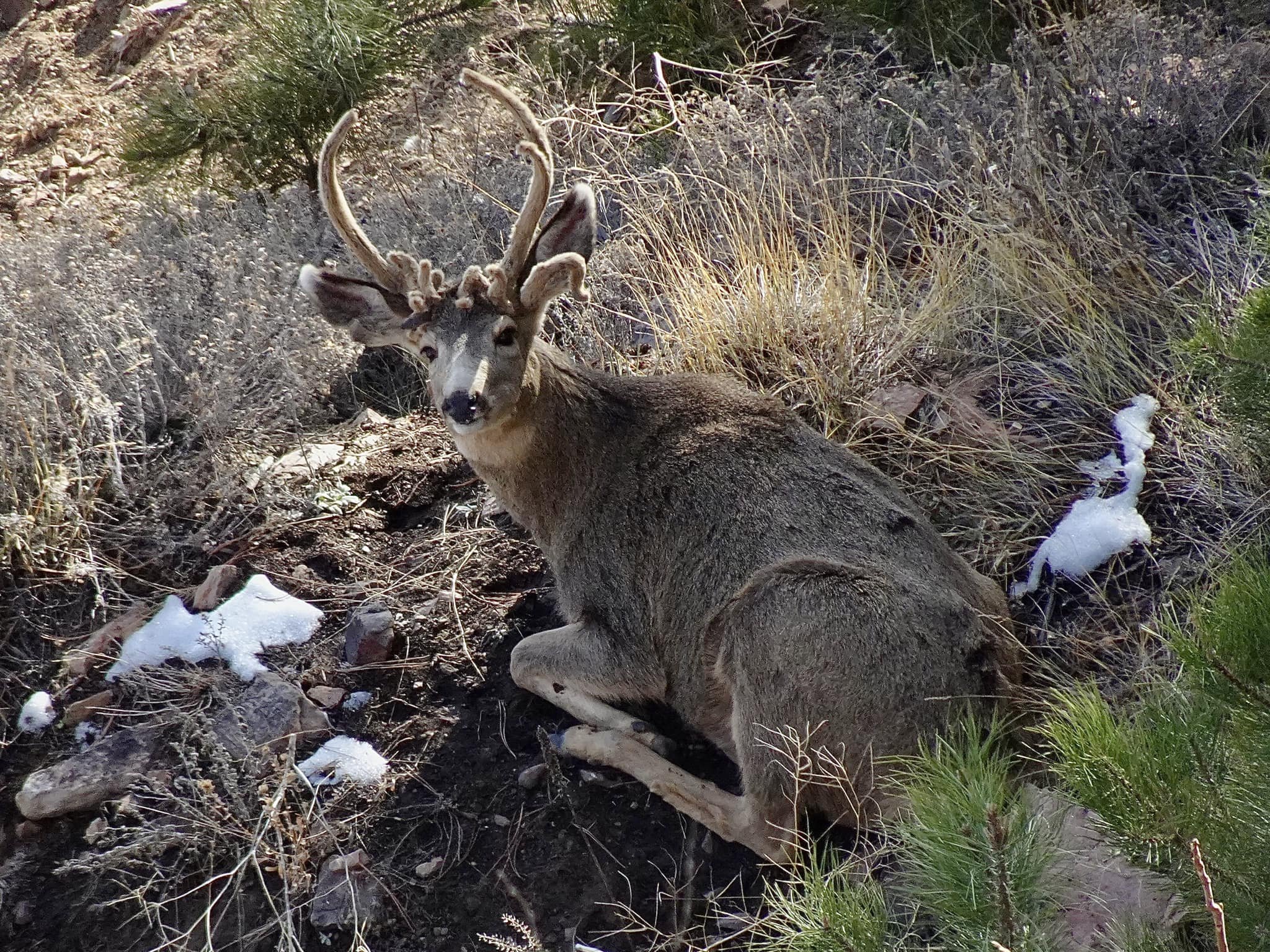Wildlife Wednesday - Squirrel Appreciation
Last Sunday, January 21, was “squirrel appreciation day”. While all the ground squirrels of the Estes Valley spend the winter hibernating under ground, our tree squirrels can be observed year round. The Estes Valley is home to two native tree squirrels - the Pine squirrel and Abert’s squirrel. How they live and where they are found differs between the two, however.
Wildlife Wednesday - Goosebumps
A sudden chill often gives us “goosebumps”. “Goosebumps” form when tiny muscles at the base of our hair follicles contract and raises our hairs. Birds and many mammals have a similar response to cold temperatures. The fluffing of the feathers or raising of hairs helps opens up pockets of air that can trap heat close to the body.
Wildlife Wednesday -- Tale of Two Weasels
The tale of two weasels. The Estes Valley is the home to both the Short-tailed and Long-tailed weasels. At first glance they look nearly identical. The Long-tailed is larger overall, however, at about 12 to 18 inches nose to tip of tail, while the Short-tailed weasel ranges from 8 to 10 inches. The tail of the Long-tailed weasel also makes up a greater proportion of its length. (Of course, weasels are very fast and the tail length is only helpful if you can see the its tail). Although rarely seen, weasels are active all year round, day and night. Breeding takes place in late summer and with the help of delayed implantation, births do not occur until late spring to early summer. Kits develop rapidly and females are able to mate the same year as their birth.
How they got here is also an interesting tale.
Wildlife Wednesday -- Mule Deer Digestion
Mule deer adapt their diet to match the season. Summer is the time of plenty- a time for rich, high carbohydrate leaves and forbs (flowering plants). This allows deer to bulk up and store fat they will need to rely on later in the year. As greenery disappears, deer reduce their intake and switch to low-carb, high fiber browse of shrubs, twigs, and needles. As ruminants, deer, like elk, moose, sheep and cows, depend on a finely tuned mix of microbes to help digestion.
Wildlife Wednesday -- WolF Reintroduction
On Monday, December 18th, 5 Grey Wolves from Oregon were released in Grand County as part of Colorado’s Grey wolf reintroduction program. How does Colorado’s effort compare to the previous reintroductions? Back in 1995 the US Fish and Wildlife Service reintroduced Grey Wolves brought from Canada to Yellowstone National Park and remote areas of Idaho. In Yellowstone, the USFWS used what is called a “soft release”. That is they held wolves in one acre pens for several weeks to allow them to adjust to their new surroundings. Twice a week they were given food — elk, deer, moose, or bison that were found dead in the park. These wolves (14 in 1995 and 17 in 1996) came from different packs so were also allowed to bond with their new neighbors. Some even mated in this captive situation. Once released, these wolves tended to stay near the pens for a week or two before going off to explore their new surroundings.
Wildlife Wednesday -- Shrews
If you see some teeny tiny tracks in the snow, you may just be looking at the path of a shrew. Shrews are our smallest mammals, many weighing less than 5 grams, about the weight of a nickel. To satisfy their voracious appetite, shrews speed through the forest litter in search of food. In fact, a shrew needs to consume at least its body weight in food daily to avoid starvation.
Wildlife Wednesday -- Cactus Buck
Now here is something you don’t see every day. This is what is referred to as a “cactus buck” and is a great example of why testosterone is such an important driver in antler development. Increasing testosterone levels initiate antler growth, allow calcification, velvet shedding, and eventually an annual loss of the antlers post rut as testosterone levels diminish to complete the cycle.
Wildlife Wednesday -- Mountain Cottontail
What is a rabbit to do when all its favorite grasses dry up in the winter? Like the other lagomorphs of the Estes Valley (pikas and snowshoe hares), Mountain Cottontails do not hibernate. While pikas collect and store food during the summer to hold them through the winter, hares and rabbits must continue to forage. They turn to a variety of dry grasses, forbs, bark, and twigs
Wildlife Wednesday -- Timing is Everything
What is the saying, “Time is of the essence?” That is the certainly the case for Mule deer at the moment. Breeding seasons are timed to allow the optimum chance of survival for offspring. For Mule deer and others that means giving birth late enough to avoid most cold and snow, while giving ample time to gain enough weight to carry them through their first winter.
Wildlife Wednesday - Let's Get Tracking!
The first snow of the season means it’s time to start tracking! Each new snow creates a fresh canvass. Just in the past day I have seen tracks of deer, elk, coyotes, fox(?), mountain lion, as well as turkeys, rabbits, voles, chipmunks, and mice. Not only do these (and many more) animals create beautiful patterns in the snow, but they also offer us a great tool for learning.
Wildlife Wednesday - Life Underground
If it seems like you are seeing a lot of new gopher mounds lately, you are right. Gopher activity peaks in spring and fall and with this year’s young recently dispersed there is now more activity than ever. Each gopher can create one to three new mounds per day. Each burrow may have a hundred or more mounds in total.
Wildlife Wednesday - Ground Squirrels & Tree Squirrels
Have you ever wondered what the difference is between a ground squirrel and a tree squirrel? While some differences may be obvious, others may surprise you. The most obvious difference is that tree squirrels are arboreal while ground squirrels are semi-fossorial. This means that tree squirrels primarily live and nest in trees and when alarmed will retreat up a tree. Ground squirrels, on the other hand, spend most of their time on the ground, dig and live in burrows, which they use for nesting, food storage, and safety.
Wildlife wednesday - flehmen response
If you have been watching the elk rut, undoubtedly you have seen this expression. What may look like a snarl or possibly a pucker is actually the flehmen response, meaning “to curl the upper lip” or “to bare the upper teeth.” In this case, the bull elk inhales with his nostrils closed and upper lip curled up in order to expose his vomeronasal organ (also known as Jacobson’s organ or VNO) located in his palate or roof of his mouth. The VNO functions as a secondary organ of smell.
Wildlife Wednesday - Changing Of The Guard
For Mule deer of the Estes Valley, September marks the changing of the guard — guard hair that is. Gone is the reddish-brown summer coat and in comes winter’s grey. While color is important in thermal regulation (red is more reflective, while grey absorbs heat) the two coats vary in other ways, too.
Then and Now: Reflecting on the 2013 Flood Ten Years Later
EVWC was created in the wake of the 2013 floods, and has now been working for an entire decade to mitigate their effects and bolster the resilience of our watershed.
Fishing Line Clean-Ups 2023
EVWC continues to coordinate volunteer groups to help clean up fishing line and other debris which poses a hazard to our water, forests, and wildlife.
Wildlife Wednesday - Labor DaY
For us humans, Labor Day marks the end of summer - a time to play or cram in as much summer as possible before the cold sets in. In the animal world, rather than a day on the calendar, they rely on the sun. Diminishing daylight tells them that the seasons are changing and it is time to get serious about preparing for season ahead. For some that means taking advantage of the bounty of fruit and seeds. For others it’s time to get down to the business of creating the next generation.
Wild Wednesday - Pine Sawyer Beetle
Smile for the camera! The Spotted pine sawyer is one of the most easily recognizable beetles in the Estes Valley. It’s long antennae and powerful jaws set it apart. As pine beetles, they are often attributed to killing trees. In reality, Pine sawyers mostly feed on already dead or dying trees, often following fires and mountain pine beetle outbreaks.
Wildlife Wednesday - The Buzz Around the Estes Valley
There is a whole lot of buzz around the Estes Valley these days. Bees are busy, flies are flying, and wasps are…..wasping? Telling one from another can often be confusing.




















